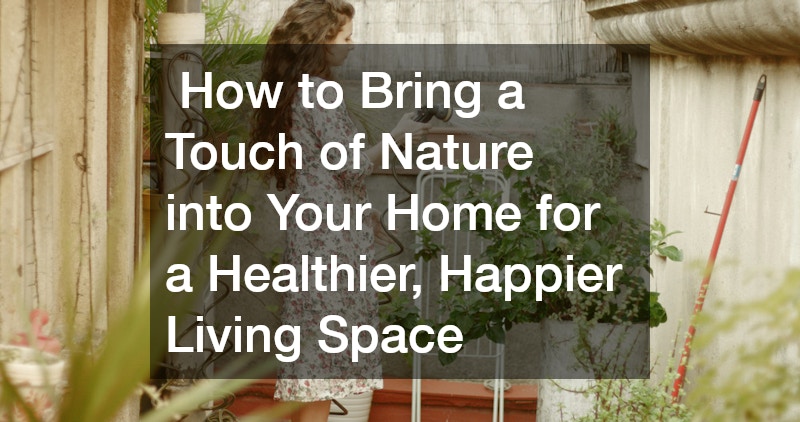Home Improvement: How to Bring a Touch of Nature into Your Home for a Healthier, Happier Living Space
Introduction
Nature has an undeniable impact on human well-being. Studies show that exposure to natural elements can improve mood, reduce stress, and even enhance cognitive function. For homeowners, integrating nature into the home isn’t just about aesthetics; it’s about creating a calming, rejuvenating space that fosters a healthier lifestyle.
But how can you bring nature indoors effectively? This guide explores actionable strategies to seamlessly blend natural elements into your home, improving its ambiance and functionality while ensuring long-term benefits.
Why Bringing Nature Indoors Matters
Before diving into the how-to, it’s essential to understand the importance of integrating nature into your home. Here are some compelling reasons:
- Improved Air Quality: Houseplants can purify indoor air by absorbing toxins and releasing oxygen. According to NASA’s Clean Air Study, certain plants can remove up to 87% of air toxins in just 24 hours.
- Enhanced Mood and Mental Health: Exposure to greenery and natural elements has been linked to lower stress levels and improved mental clarity. Studies indicate that people who spend time in nature or have natural elements in their environment experience a 15% increase in overall well-being.
- Increased Property Value: Homes with eco-friendly features and natural aesthetics tend to attract higher resale values. According to Zillow, homes with sustainable or green features sell for 4-7% more than those without.
- Sustainability and Energy Efficiency: Strategic use of natural light, ventilation, and organic materials can reduce energy consumption and lower utility bills. The U.S. Department of Energy states that maximizing natural daylight can cut lighting costs by 50-80%.
Now, let’s explore practical ways to bring nature into your home.
1. Incorporate Houseplants for Fresh Air and Aesthetics

One of the easiest ways to bring nature into your home is by adding houseplants. They not only enhance decor but also improve indoor air quality by filtering pollutants like formaldehyde, benzene, and carbon monoxide.
Best Low-Maintenance Houseplants for US Homes:
- Snake Plant (Sansevieria): Requires minimal care and thrives in low light. It also removes toxins from the air, making it one of the best plants for bedrooms.
- Peace Lily (Spathiphyllum): Removes toxins and adds a touch of elegance. According to NASA, it can reduce airborne mold by up to 60%.
- Aloe Vera: Useful for air purification and minor burns. It also increases indoor oxygen levels at night.
- Spider Plant (Chlorophytum comosum): A resilient, air-purifying plant perfect for beginners. It reduces airborne toxins like formaldehyde by up to 90%.
- Pothos (Epipremnum aureum): Thrives in various lighting conditions and is excellent for hanging baskets.
Houseplant Maintenance Tips:
- Ensure proper drainage in pots to avoid overwatering.
- Position plants based on their sunlight and humidity needs.
- Rotate plants occasionally to promote even growth.
- Use natural fertilizers, such as compost tea or banana peels, to keep your plants healthy.
2. Maximize Natural Light and Fresh Air

Sunlight and ventilation play a crucial role in making your home feel connected to nature. Here’s how to maximize them:
Ways to Enhance Natural Light:
- Install Larger Windows or Skylights: These additions can dramatically brighten up your space and reduce dependence on artificial lighting.
- Use Light-Colored Curtains or Blinds: Sheer materials allow sunlight to filter through while maintaining privacy.
- Opt for Mirrors and Reflective Surfaces: Strategically placed mirrors can amplify natural light, making rooms appear larger and more vibrant.
Improving Ventilation for Fresher Indoor Air:
- Install Operable Glass Walls or Sliding Doors: This allows seamless access to outdoor spaces and improves airflow.
- Use Ceiling Fans to Promote Air Circulation: Reducing reliance on artificial cooling can lower energy costs.
- Incorporate Ventilated Skylights or Roof Windows: Enhancing airflow, particularly in attic spaces, can prevent stuffiness and improve air quality.
3. Introduce Natural Materials in Interior Design
Using organic materials in furniture, decor, and construction enhances a home’s connection to nature.
Natural Material Ideas:
- Wood: Opt for reclaimed wood furniture, flooring, or exposed beams. The use of natural wood can lower stress levels and heart rates by up to 20%, according to research from Japan’s Forestry and Forest Products Research Institute.
- Stone: Use granite or marble for countertops, or add a stone accent wall for a luxurious touch.
- Bamboo: Ideal for flooring, furniture, and even decorative accents, as it is sustainable and durable.
- Wicker & Rattan: These materials bring a cozy, natural touch to seating and decor.
- Clay & Terracotta: Great for planters, pottery, and rustic design elements, adding warmth and texture to your interiors.
4. Create an Indoor Herb Garden
An indoor herb garden is both functional and decorative, allowing you to enjoy fresh herbs year-round.
Best Herbs to Grow Indoors:
- Basil: Thrives in sunlight and is perfect for cooking.
- Mint: Grows well in pots and adds a fresh aroma, which can also repel insects.
- Rosemary: Hardy and aromatic, great for seasoning dishes and promoting better digestion.
- Parsley: Easy to grow and packed with nutrients like Vitamin C.
- Thyme: Requires minimal care and enhances food flavors.
Setting Up an Indoor Herb Garden:
- Use a sunny windowsill or grow lights for proper illumination.
- Choose self-watering pots for convenience.
- Maintain well-draining soil and occasional fertilization.
- Ensure air circulation to prevent mold growth on plants.
5. Use Nature-Inspired Colors and Textures
Nature-inspired color palettes can significantly impact your home’s ambiance. Consider these options:
Earthy Color Schemes:
- Forest Greens & Mossy Tones: Evoke a calming, organic feel.
- Sandy Beiges & Soft Browns: Create a warm, inviting space.
- Sky Blues & Oceanic Shades: Promote relaxation and openness.
- Terracotta & Burnt Orange: Add vibrancy while maintaining a natural look.
6. Smart Financial Planning for Nature-Inspired Upgrades
Investing in eco-friendly and nature-infused home improvements doesn’t have to break the bank. Here are financial planning tips:
- Set a Budget: Prioritize upgrades that provide the best return on investment.
- Look for Tax Credits: Some eco-friendly modifications qualify for tax benefits.
- Choose Energy-Efficient Materials: Saves money in the long run.
- DIY Small Projects: Simple enhancements like plant decor and repurposed wood can be done affordably.
Conclusion
Bringing nature into your home isn’t just a trend—it’s a lifestyle shift that fosters wellness, enhances aesthetics, and improves overall home value. By implementing even a few of these ideas, you can create a more peaceful, refreshing living environment that positively impacts your daily life. Start small, experiment with natural elements, and watch your home transform into a serene retreat that harmonizes with the outdoors.

Post Comment